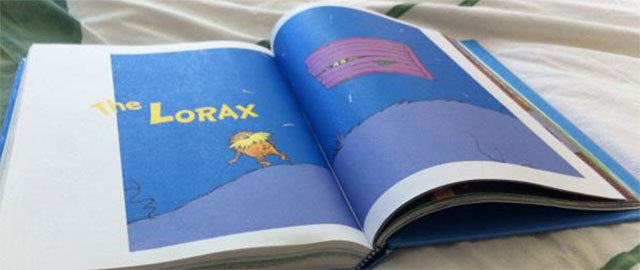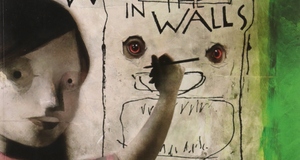From Earth Common Journal VOL. 4 NO. 1An Investigation into the Impact of Children's Literature Through a Review of Dr. Seuss's The LoraxWithin mere months of The Lorax’s publication the Keep America Beautiful campaign recognized the story’s potential to resonate with generations, and presented Seuss with an award (Miller, 2012, para. 11), followed shortly after by recognition from the Anti-Litter Association (Nel, 2010, The Lorax and The Butter Battle Book, para. 4). Since then, the Lorax has become a representative of Earth Day (Miller, 2012, para. 11). Further validation of the book’s effectiveness occurred when the Lorax became more accessible to readers: [The Lorax was] a fictional character with real enemies. Parents in logging communities have tried to get the book removed from school libraries and reading lists. The National Oak Flooring Manufacturers Association has published its own pro-logging rebuttal, Truax. Seuss’s The Lorax has even made the American Library Association’s annual list of challenged and banned books. (Nel, 2010, The Lorax and The Butter Battle Book, para. 5). The enduring nature of this story and the audience for which it has been written makes The Lorax an important ecology text, and if doubt of its effects still exist, consider that Dr. Seuss is not the only one that recognizes the importance of presenting information throughout the developmental years. The oil and gas industry has also taken steps to position itself within the consciousness of children. Currently, the industry is receiving backlash from both Greenpeace and from the Alberta opposition over actions that are clearly attempts to provide information and exposure to children during their influential, early years. Deron Bilous, Alberta NDP education critic, blasted the Alberta government’s plan to involve the oil and gas industry in the development of the province’s education system: “‘Kindergarten to grade three is a very formative time in a child’s education where their minds are still developing. It is outrageous and appalling to have oil and gas companies involved in any way in developing curriculum for Alberta’s youngest students,’ he said.” (Linnitt, 2014, para. 4) And that is not the only target. Greenpeace has launched a campaign against LEGO’s partnership with Royal Dutch Shell, in what they claim is the pollution of children’s ideas and imaginations (McGrath, 2014, para. 6). Greenpeace suggests the action demonstrates that “Shell is building brand loyalty with the next generation of consumers. . . . to prop up its public image, while threatening the Arctic with a deadly oil spill” (Greenpeace qtd. in McGrath, 2014, para. 6). ConclusionAs Baratz and Abu Hazeira (2012) point out the following: “on the assumption that textbooks are one of the important tools for conveying ethical messages and for structuring the social reality of the students (Apple & Christian-Smith, 1991; Helinger & Brooks, 1991), then accordingly one can also see in literature written for children an aesthetic-didactic objective, by way of examination of the cultural-ideological code of the society.” (p. 34) And with that understanding in mind, in 2011, 40 years after the book was first published, “. . . Emma Marris of Nature, the science journal, called the book ‘a kind of Silent Spring for the playground set,’ referring to the 1962 work by Rachel Carson that is often said to have launched the modern environmental movement” (Miller, 2012, para. 11) Can it then be accepted, that Dr. Seuss’s The Lorax is an important part of environmental literature, attributed with helping to instill environmental awareness in children? AuthorA. Rachelle Foss, Bachelor of Applied Communications in Professional Writing, MacEwan University, Edmonton, Alberta, Canada. Rachelle is in her third year at MacEwan University. She has worked as a writer and editor for The Western Sentinel and as a copy editor for NAIT. She has published an article in each edition of the Earth Common Journal since its inaugural year in 2011. She is an avid naturalist and draws inspiration from her passion for the environment. Cadence Foss, attends Grade 6 at Namao Elementary School. She enjoys singing for an audience, and is an active member of her school community, taking part in programs like the Me-To-We Club and helping others. Eden Foss, attends Grade 3 at Namao Elementary School. She has a yellow belt in karate and is a member of her school running club. She loves animals and is always looking for ways to work with them in positive ways. ReferencesBaratz, L., & Abu Hazeira, H. (2012). “Children’s Literature as an Important Tool for Education of Sustainability and the Environment.” International Electronic Journal of Environmental Education. Vol 2, Issue 1, Jan 2012. Carlton, E. (2006, Oct 1). “Learning Through Music: The Support of Brain Research.” Retrieved from http://www.communityplaythings.com/resources/articles/2006/learning-through-music-the-support-of-brain-research Klein, A. J. (2003). Humor in Children’s Lives: A Guide for Practitioners. Westport, CT: Greenwood Publishing Group, Inc. Linnitt, C. (2014, March 12). “Alberta Partners with Major Oilsands Companies to Develop Kindergarten to Grade Three Curriculum”. Desmog Canada. Desmog.ca. Retrieved from http://desmog.ca/2014/03/11/alberta-partners-major-oilsands-companies-develop-kindergarten-grade-3-curriculum Literary Devices. (2014). Definition of Anapest. Retrieved from http://literarydevices.net/anapest/ Lacina, J., & Stetson, R. (2013) “Using Children’s Literature to Support Positive Behaviours”. Young Children. Miller, J. J. (2012) “Friends of the Lorax.” HeyMiller.com. 2012, March 2. Retrieved from: http://www.heymiller.com/2012/03/friends-of-the-lorax/ Nel, P. (2010). “Dr.Seuss’s Biography/Author/The Lorax and The Butter Battle Book.” Seussville.com. Retrieved from: http://www.seussville.com/#/author Nel, P. (2012, March 1). “Dr. Seuss: Children’s Books “Have a Greater Potential for Good or Evil, Than Any Other Form of Literature on Earth.” Writing for Children: A Mission/Flood of Treacle. Retrieved from: http://www.philnel.com/2012/03/01/seussmission/ Seuss, Dr. (1991). Six by Seuss: A Treasury of Dr. Seuss Classics. “The Lorax” (1971). New York, NY: Random House Children’s Books. Print. Sloane, A. (2010). Reading The Lorax, Orienting in Potentiality” Environmental Education Research. Vol 16, Nos 3-4, June-August 2010, 415-428. McGrath, T. (2014, July 11). “Greenpeace Slams LEGO for its Brand Partnership with Shell.” Salon.com. Retrieved from http://www.salon.com/2014/07/11/greenpeace_slams_lego_for_its_brand_partnership_with_shell_oil_partner/ Suggested Reading from Inquiries Journal
Inquiries Journal provides undergraduate and graduate students around the world a platform for the wide dissemination of academic work over a range of core disciplines. Representing the work of students from hundreds of institutions around the globe, Inquiries Journal's large database of academic articles is completely free. Learn more | Blog | Submit Latest in Literature |
















